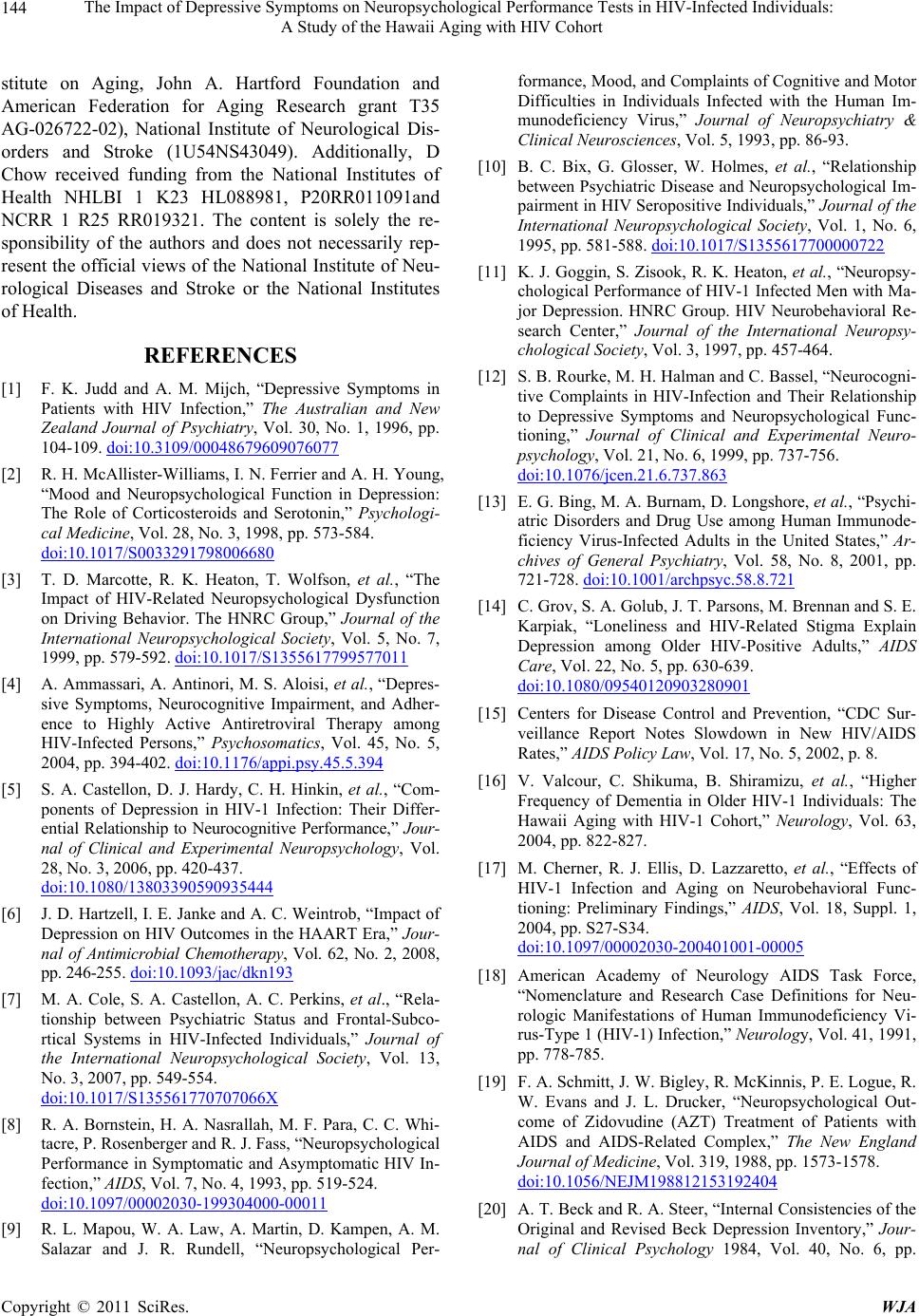
The Impact of Depressive Symptoms on Neuropsychological Performance Tests in HIV-Infected Individuals:
144
A Study of the Hawaii Aging with HIV Cohort
stitute on Aging, John A. Hartford Foundation and
American Federation for Aging Research grant T35
AG-026722-02), National Institute of Neurological Dis-
orders and Stroke (1U54NS43049). Additionally, D
Chow received funding from the National Institutes of
Health NHLBI 1 K23 HL088981, P20RR011091and
NCRR 1 R25 RR019321. The content is solely the re-
sponsibility of the authors and does not necessarily rep-
resent the official views of the National Institute of Neu-
rological Diseases and Stroke or the National Institutes
of Health.
REFERENCES
[1] F. K. Judd and A. M. Mijch, “Depressive Symptoms in
Patients with HIV Infection,” The Australian and New
Zealand Journal of Psychiatry, Vol. 30, No. 1, 1996, pp.
104-109. doi:10.3109/00048679609076077
[2] R. H. McAllister-Williams, I. N. Ferrier and A. H. Young,
“Mood and Neuropsychological Function in Depression:
The Role of Corticosteroids and Serotonin,” Psychologi-
cal Medicine, Vol. 28, No. 3, 1998, pp. 573-584.
doi:10.1017/S0033291798006680
[3] T. D. Marcotte, R. K. Heaton, T. Wolfson, et al., “The
Impact of HIV-Related Neuropsychological Dysfunction
on Driving Behavior. The HNRC Group,” Journal of the
International Neuropsychological Society, Vol. 5, No. 7,
1999, pp. 579-592. doi:10.1017/S1355617799577011
[4] A. Ammassari, A. Antinori, M. S. Aloisi, et al., “Depres-
sive Symptoms, Neurocognitive Impairment, and Adher-
ence to Highly Active Antiretroviral Therapy among
HIV-Infected Persons,” Psychosomatics, Vol. 45, No. 5,
2004, pp. 394-402. doi:10.1176/appi.psy.45.5.394
[5] S. A. Castellon, D. J. Hardy, C. H. Hinkin, et al., “Com-
ponents of Depression in HIV-1 Infection: Their Differ-
ential Relationship to Neurocognitive Performance,” Jour-
nal of Clinical and Experimental Neuropsychology, Vol.
28, No. 3, 2006, pp. 420-437.
doi:10.1080/13803390590935444
[6] J. D. Hartzell, I. E. Janke and A. C. Weintrob, “Impact of
Depression on HIV Outcomes in the HAART Era,” Jour-
nal of Antimicrobial Chemotherapy, Vol. 62, No. 2, 2008,
pp. 246-255. doi:10.1093/jac/dkn193
[7] M. A. Cole, S. A. Castellon, A. C. Perkins, et al., “Rela-
tionship between Psychiatric Status and Frontal-Subco-
rtical Systems in HIV-Infected Individuals,” Journal of
the International Neuropsychological Society, Vol. 13,
No. 3, 2007, pp. 549-554.
doi:10.1017/S135561770707066X
[8] R. A. Bornstein, H. A. Nasrallah, M. F. Para, C. C. Whi-
tacre, P. Rosenberger and R. J. Fass, “Neuropsychological
Performance in Symptomatic and Asymptomatic HIV In-
fection,” AIDS, Vol. 7, No. 4, 1993, pp. 519-524.
doi:10.1097/00002030-199304000-00011
[9] R. L. Mapou, W. A. Law, A. Martin, D. Kampen, A. M.
Salazar and J. R. Rundell, “Neuropsychological Per-
formance, Mood, and Complaints of Cognitive and Motor
Difficulties in Individuals Infected with the Human Im-
munodeficiency Virus,” Journal of Neuropsychiatry &
Clinical Neurosciences, Vol. 5, 1993, pp. 86-93.
[10] B. C. Bix, G. Glosser, W. Holmes, et al., “Relationship
between Psychiatric Disease and Neuropsychological Im-
pairment in HIV Seropositive Individuals,” Journal of the
International Neuropsychological Society, Vol. 1, No. 6,
1995, pp. 581-588. doi:10.1017/S1355617700000722
[11] K. J. Goggin, S. Zisook, R. K. Heaton, et al., “Neuropsy-
chological Performance of HIV-1 Infected Men with Ma-
jor Depression. HNRC Group. HIV Neurobehavioral Re-
search Center,” Journal of the International Neuropsy-
chological Society, Vol. 3, 1997, pp. 457-464.
[12] S. B. Rourke, M. H. Halman and C. Bassel, “Neurocogni-
tive Complaints in HIV-Infection and Their Relationship
to Depressive Symptoms and Neuropsychological Func-
tioning,” Journal of Clinical and Experimental Neuro-
psychology, Vol. 21, No. 6, 1999, pp. 737-756.
doi:10.1076/jcen.21.6.737.863
[13] E. G. Bing, M. A. Burnam, D. Longshore, et al., “Psychi-
atric Disorders and Drug Use among Human Immunode-
ficiency Virus-Infected Adults in the United States,” Ar-
chives of General Psychiatry, Vol. 58, No. 8, 2001, pp.
721-728. doi:10.1001/archpsyc.58.8.721
[14] C. Grov, S. A. Golub, J. T. Parsons, M. Brennan and S. E.
Karpiak, “Loneliness and HIV-Related Stigma Explain
Depression among Older HIV-Positive Adults,” AIDS
Care, Vol. 22, No. 5, pp. 630-639.
doi:10.1080/09540120903280901
[15] Centers for Disease Control and Prevention, “CDC Sur-
veillance Report Notes Slowdown in New HIV/AIDS
Rates,” AIDS Policy Law, Vol. 17, No. 5, 2002, p. 8.
[16] V. Valcour, C. Shikuma, B. Shiramizu, et al., “Higher
Frequency of Dementia in Older HIV-1 Individuals: The
Hawaii Aging with HIV-1 Cohort,” Neurology, Vol. 63,
2004, pp. 822-827.
[17] M. Cherner, R. J. Ellis, D. Lazzaretto, et al., “Effects of
HIV-1 Infection and Aging on Neurobehavioral Func-
tioning: Preliminary Findings,” AIDS, Vol. 18, Suppl. 1,
2004, pp. S27-S34.
doi:10.1097/00002030-200401001-00005
[18] American Academy of Neurology AIDS Task Force,
“Nomenclature and Research Case Definitions for Neu-
rologic Manifestations of Human Immunodeficiency Vi-
rus-Type 1 (HIV-1) Infection,” Neurology, Vol. 41, 1991,
pp. 778-785.
[19] F. A. Schmitt, J. W. Bigley, R. McKinnis, P. E. Logue, R.
W. Evans and J. L. Drucker, “Neuropsychological Out-
come of Zidovudine (AZT) Treatment of Patients with
AIDS and AIDS-Related Complex,” The New England
Journal of Medicine, Vol. 319, 1988, pp. 1573-1578.
doi:10.1056/NEJM198812153192404
[20] A. T. Beck and R. A. Steer, “Internal Consistencies of the
Original and Revised Beck Depression Inventory,” Jour-
nal of Clinical Psychology 1984, Vol. 40, No. 6, pp.
Copyright © 2011 SciRes. WJA